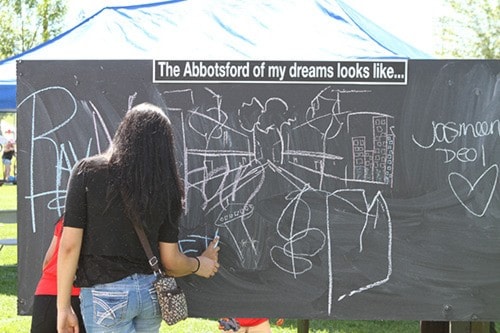While Abbotsford is “its own city in its own right” – an economic hub with a university, hospital and self-sufficient local economy – the neighbourhoods are not as complete, said Jennifer Fix at a meeting with city councillors on Jan. 19.
Fix is a senior planner and project manager with Dialog, the consultant working on Abbotsford’s new official community plan project (OCP) – called Abbotsforward.
An OCP guides decision-making on growth and development in a city. Abbotsford’s last OCP was created in 2005. The new document, when completed, guides how future development occurs in different areas of the city as the population increases.
Fix said Abbotsford has many places to shop, dine out, and access services, but not many are within walking distance of where people live. Only one in four people in Abbotsford are within a 10-minute walk from home from a grocery store, she said.
Abbotsford has many trails and parks for recreation – 85 per cent of residents are within a five-minute walk of a park – and people who live here say that is important to them, explained Fix. But while recreation is available, walking and cycling to move around the city is more complicated, she said. Fix explained that getting people to walk or cycle is about density and connectivity – giving people simple paths to places they want to go.
“The way you lay out your city has everything to do with the kind of choice you are providing people.”
Abbotsford has a lot of community spaces, such as galleries and churches, which people see as the heart of their communities – but there are not as many informal places where people can gather, such as sidewalk cafes, said Fix.
While Abbotsford is the heart of the Fraser Valley, when people are asked what the heart of Abbotsford is, “it’s a little bit less clear.” Finding the heart of the city and neighbourhoods will be an important part of the OCP process, said Fix.
Abbotsford is growing and with medium growth, the city will reach a population of about 200,000 in about 20 years. If the city grows more rapidly, it could hit that population in 15 years, said Fix. There are outside constraints that shape how Abbotsford can grow, including the Agricultural Land Reserve, environmentally sensitive areas, and mountainous terrain. Fix said that while Abbotsford celebrates its status as “the city in the country,” in recent years, development has been neither city nor country, but instead has been suburban.
Brent Toderian, a planner and strategic advisor with Dialog, said the former OCP was so flexible that it did not provide clarity to developers, which can lead to development shying away from the community.
Toderian explained that the OCP needs to be a plan for tomorrow, not yesterday or today – adding that “this is a plan for the future.”
Over the next six weeks, the city will run a promotional campaign encouraging people to get involved and share their ideas for the future of Abbotsford. There will be an online survey where residents can make their ideas known, or they can visit the travelling road shows to talk with city planners, and join neighbourhood walks and citizen circles, where people can talk with neighbours, family and friends about their plans.
For more information on Abbotsforward and the online survey, visit www.abbotsforward.ca. To get in touch, email info@abbotsforward.ca, phone 604-864-5510, or follow @abbotsforward on Twitter.
